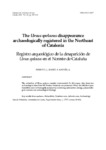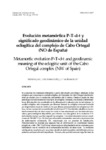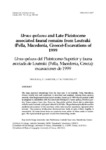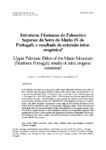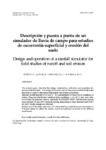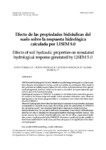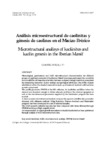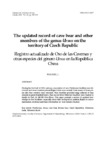Buscar
Mostrando ítems 1-10 de 37
The Ursus spelaeus disappearance archaeologically registered in the Northeast of Catalonia
(Universidade da Coruña, 2001)
The extinction of Ursus spelaeus remains controversial. In this paper, data from two archaeological sites from NE Iberian Peninsula are presented. Thus, the Middle-Upper Paleolithic term is thoroughly analysed by combining ...
Evolución metamórfica P-T-d-t y significado geodinámico de la unidad eclogítica del complejo de Cabo Ortegal (NO de España)
(Universidade da Coruña, 2001)
Se presentan los resultados obtenidos a partir del estudio petrológico detallado de las eclogitas que componen la unidad eclogítica del Complejo de Cabo Ortegal estableciéndose un modelo para la evolución metamórfica de ...
New excavation campaigns in the Upper Pleistocene cave bear site Potocka zijalka, Slovenia - state of investigation
(Universidade da Coruña, 2001)
[Abstract] Potocka zijalka is a unique site with rich archaeological and palaeontological remains. From 1997 onward new excavation campaigns were carried out in co-operation with the Institute of Geology in Ljubljana and ...
Ursus spelaeus and Late Pleistocene associated faunal remains from Loutraki (Pella, Macedonia, Greece)-Excavations of 1999
(Universidade da Coruña, 2001)
[Abstract] The large mammal assemblage from the bear-cave A in Loutraki, Pella, Macedonia, Greece, mostly very well preserved, is described and analysed. Among Ursus spelaeus remains, other large mammalian faunal remains, ...
Estruturas Filonianas do Paleozóico Superior da Serra do Marão (N de Portugal); o resultado de extensão intraorogénica?
(Universidade da Coruña, 2001)
[Abstract] In the Marão mountain occur hercynian mafic veins cutting the Schistose Formation of the Landeilian age. The geochemistry of these rocks present high concentrations on Ti ,P, Zr, Nb, Ba, and REE (Ti O2= 1.23-1,39 ...
Descripción y puesta a punto de un simulador de lluvia de campo para estudios de escorrentía superficial y erosión del suelo
(Universidade da Coruña, 2001)
[Abstract] The present paper describes the design, construction, calibration and operation of a spray rainfall simulator . The design of the plots used for the purpose of this study is also described in order to determine ...
Efecto de las propiedades hidráulicas del suelo sobre la respuesta hidrológica calculada por LISEM 5.0
(Universidade da Coruña, 2001)
[Abstract] LISEM model (Limburg Soil Erosion Model) is actually being developped in order to perform dynamic simulations of surface runoff and erosion in catchments. This model is also proposed as analysis support system ...
Análisis microestructural de caolinitas y génesis de caolines en el Macizo Ibérico
(Universidade da Coruña, 2001)
[Abstract] Mineralogical, geochemical and XRD microstructural characterization for different groups of argillized materials of the Iberian Massif have been performed; the variability and correllation of these characteristics ...
The updated record of cave bear and other members of the genus Ursus on the territory of Czech Republic
(Universidade da Coruña, 2001)
[Abstract] During the 2nd half of 20th century, a succession of new Pleistocene localities was discovered and some classical paleontological sites were revised. From many of those places also bear remains were recorded. ...
A palaeobiological approach to the cave bears from Liñares and Eirós (Galicia, Spain)
(Universidade da Coruña, 2001)
[Abstract] The sites of Liñares and Eirós are closely situated in the NW of Spain and both contains a large number of Ursus spelaeus remains. However, the chronology of these sites is different and correspond to different ...


